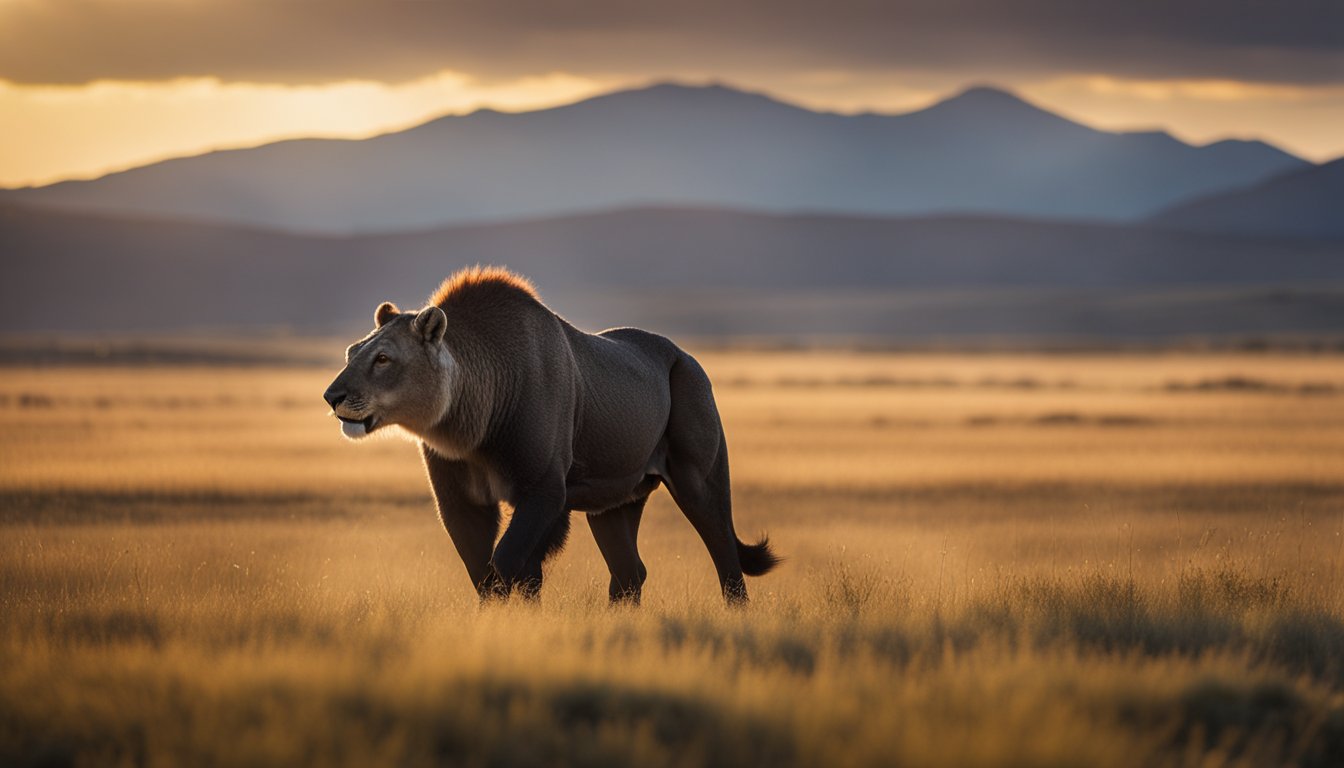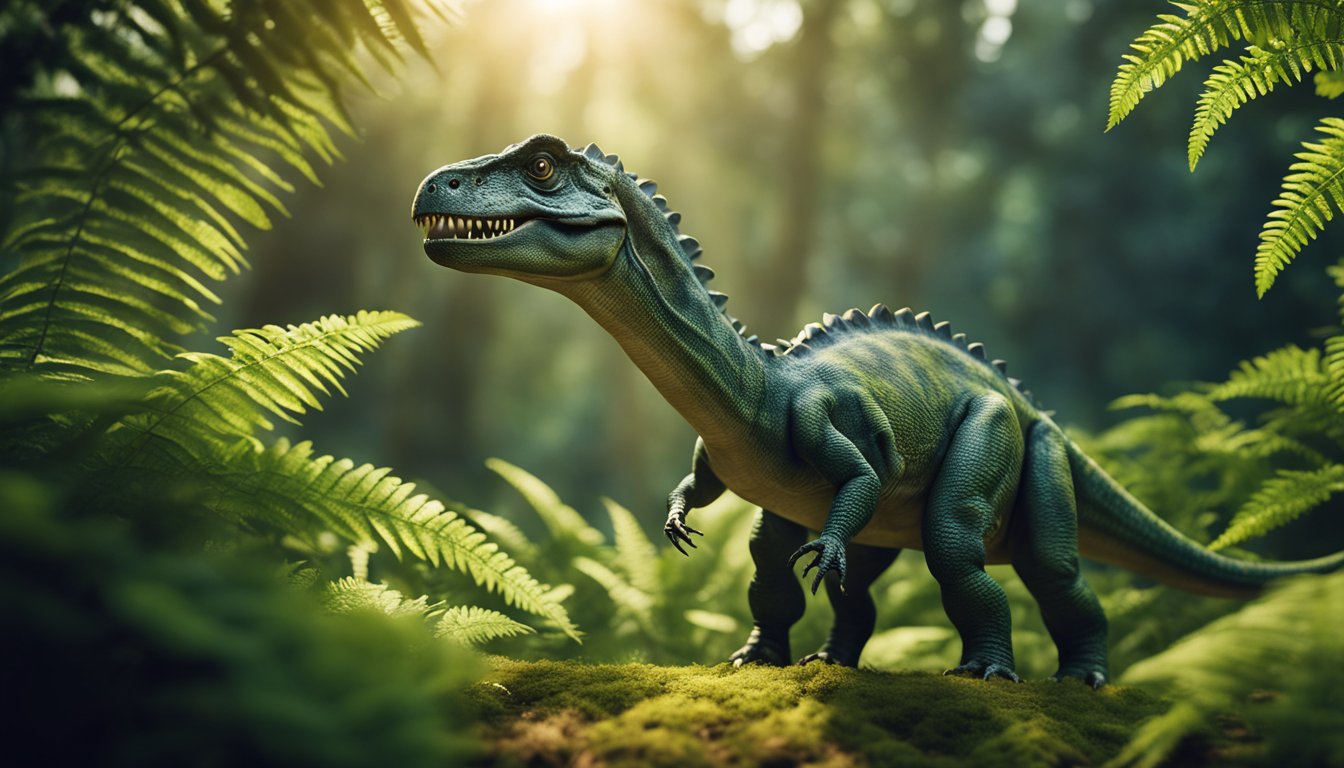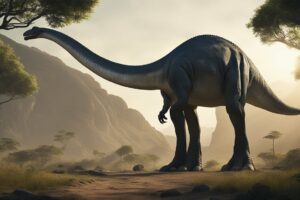Hyaenodon: The Mighty Scavenger of the Ancient Plains

Meet Hyaenodon, the top predator and scavenger of the ancient plains.
This fascinating creature lived during the Eocene and Oligocene epochs, which lasted from 56 million to 34 million years ago.
Its fossils have been found across the globe, spanning from North America, Europe, Africa, to Asia.
Scientists believe that Hyaenodon preferred terrestrial habitats, roaming the open plains and woodlands in search of prey.
Hyaenodon was an impressive creature, with the larger forms dominating the landscapes throughout the Oligocene periods.
Key to this success was the large head that compared to today’s animals looks too large to fit upon the body.
Indeed, the neural spines of the forward dorsal vertebrae are enlarged to allow for an even larger attachment area for the massive muscles that powered the bite.
Hyaenodon was a true carnivore, feeding on a variety of prey ranging from small mammals to large herbivores.
However, it was also an opportunistic scavenger, feeding on the remains of other animals that it found on the ancient plains.
Unearthing the Hyaenodon: Discovering an Ancient Predator
Fossil Records and Species Diversity
Hyaenodon was a genus of carnivorous mammals that lived in the Eocene and Oligocene epochs, between 56 million to 34 million years ago.
These ancient predators roamed the open plains and woodlands in search of prey.
Fossil records show that Hyaenodon lived in North America, Europe, Africa, and Asia.
Over 30 species within the genus showed the diversity and evolution of these animals.
Scientists have discovered fossils of Hyaenodon in various locations, including North Dakota, Wyoming, and Europe.
These fossils have allowed researchers to study the physical characteristics and behavior of Hyaenodon.
Physical Characteristics: Skulls and Teeth
Hyaenodon was a large predator that could grow up to 5 feet long.
Its long legs suggest that it could run, but probably not fast because of its spreading toes.
Its strong canines, large premolars, and shearing carnassial teeth indicate that Hyaenodon was probably an active hunter and also a scavenger like the modern-day hyena.
Hyaenodon’s skull was long and narrow, with a flattened snout and a powerful jaw.
Its sharp teeth were designed for slicing meat, and its carnassial teeth were used for shearing flesh.
The structure of its teeth allowed it to crush bones, which made it an effective scavenger.
Fun fact: Did you know that the largest species of Hyaenodon, Hyaenodon gigas, weighed up to 1,000 pounds? That’s as heavy as a small car!
In conclusion, the discovery of Hyaenodon fossils has allowed scientists to gain insight into the physical characteristics and behavior of this ancient predator.
Its strong teeth and powerful jaw made it a formidable hunter and scavenger, and its fossils have helped researchers understand the diversity and evolution of Hyaenodon species.
The Hyaenodon’s World: Habitat and Hunting Grounds

The Hyaenodon, a mighty scavenger of the ancient plains, lived during the Eocene, Oligocene, and Miocene epochs, spanning from 56 to 34 million years ago.
Its fossils have been found across the globe, from North America and Europe to Africa and Asia.
Scientists believe that Hyaenodon preferred terrestrial habitats, roaming the open plains and woodlands in search of prey.
Adaptations to Diverse Ecosystems
The Hyaenodon was well-adapted to diverse ecosystems. Its long legs suggest it could run, but probably not fast due to its spreading toes.
Its strong canines, large premolars, and shearing carnassial teeth indicate that Hyaenodon was probably an active hunter and also a scavenger like the modern-day hyena.
Its keen sense of smell and hearing allowed it to detect prey from a distance, while its sharp teeth and powerful jaws made it an apex predator.
Predatory Behavior and Diet
The Hyaenodon was a carnivorous mammal that fed on meat. Its diet included a variety of prey, from small rodents to large herbivores.
The Hyaenodon’s predatory behavior and diet varied depending on its habitat.
In North America, Hyaenodon fossils have been found in areas that were once covered by forests and swamps, suggesting that it may have hunted in these environments.
In Europe, Hyaenodon fossils have been found in open grasslands, suggesting that it may have hunted in these areas as well.
In Africa, Hyaenodon fossils have been found in areas that were once covered by woodlands and savannas.
The Hyaenodon may have scavenged from the kills of other predators, such as lions and hyenas, in these areas.
In Asia, Hyaenodon fossils have been found in open grasslands and woodlands, suggesting that it may have hunted in these areas as well.
Fun fact: The Hyaenodon was one of the largest carnivorous mammals of its time, with some species reaching up to 6 feet in length and weighing over 200 pounds.
The Rise and Fall of the Hyaenodon Dynasty

Evolutionary Success and Dominance
Hyaenodon, a member of the Hyaenodontidae family, was a carnivorous mammal that lived during the Eocene and Miocene epochs, between 42 and 5 million years ago.
They were part of a group called creodonts, which were the dominant carnivores during the late Eocene, and early Miocene periods.
Hyaenodon was the largest of the creodonts, and their size and strength allowed them to dominate the ancient plains.
Hyaenodon was highly successful and adapted to various environments, from forests to grasslands.
They had a unique skull structure that allowed them to exert a powerful bite force, making them formidable predators.
They were also scavengers and could feed on carrion, making them highly adaptable to changes in their environment.
Extinction: The End of an Era
Despite their evolutionary success, the Hyaenodon dynasty came to an end during the Miocene epoch, around 5 million years ago.
The cause of their extinction is still a topic of debate among scientists, but it is believed that climate change played a significant role.
During the Miocene epoch, the climate became cooler and drier, and grasslands replaced forests.
This change in vegetation may have affected the food sources of Hyaenodon and other large carnivores, leading to their decline and eventual extinction.
Additionally, the rise of other carnivorous mammals such as canids, felids, and ursids may have also contributed to the downfall of the Hyaenodon dynasty.
These new predators were better adapted to the changing environment and had more diverse diets.
Despite their extinction, Hyaenodon left a lasting legacy.
Their powerful bite force and unique skull structure influenced the evolution of other carnivorous mammals, including modern-day hyenas.
Hyaenodon was a mighty scavenger of the ancient plains, and their story is a testament to the ever-changing nature of our planet’s ecosystems.
Fun Fact: The name Hyaenodon means “hyena tooth,” but they were not closely related to modern-day hyenas.
Frequently Asked Questions

What kind of environment did the Hyaenodon roam in during its time on Earth?
Hyaenodon lived during the Eocene and Oligocene epochs, which lasted from 56 million to 34 million years ago.
Fossil records suggest that Hyaenodon preferred terrestrial habitats, roaming the open plains and woodlands in search of prey.
They were found across the globe, spanning from North America, Europe, Africa, to Asia.
Can you tell me about the diet of the Hyaenodon and how it scavenged?
Hyaenodon was an omnivore, which means it ate both plants and animals. However, it was primarily a scavenger, feeding on the carcasses of dead animals.
Hyaenodon had massive jaw muscles that allowed it to bite right through an animal’s skull to kill it.
They also had sharp teeth that could crush bones and tear flesh.
How did the Hyaenodon compare in size to today’s predators?
Hyaenodon was huge even by modern standards. The largest Hyaenodont was Hyaenodon gigas, and it stood 4.5 feet tall at the shoulder, or 1.4 meters.
In comparison, the largest living predator, the polar bear, stands at around 3.5 feet at the shoulder.
What sort of adaptations did the Hyaenodon have to survive as a scavenger?
Hyaenodon had several adaptations to survive as a scavenger. They had a keen sense of smell, which helped them locate carcasses from far away.
They also had strong jaws and teeth that could crush bones, which allowed them to access the nutrient-rich marrow inside.
Additionally, they had long legs that allowed them to cover great distances while scavenging.
Are there any modern animals that share characteristics with the Hyaenodon?
While Hyaenodon is extinct, there are still some modern animals that share similar characteristics.
For example, the spotted hyena is a scavenger that has a similar bone-crushing jaw structure to Hyaenodon.
The vulture is another scavenger that has a keen sense of smell and can locate carcasses from far away.
What led to the eventual extinction of the Hyaenodon species?
The exact reason for the extinction of Hyaenodon is not known.
However, it is believed that changes in the climate and competition from other predators played a role.
As the climate changed, the open plains and woodlands that Hyaenodon preferred began to disappear, and they were unable to adapt to the new environment.
Additionally, the emergence of new predators may have led to increased competition for resources.






